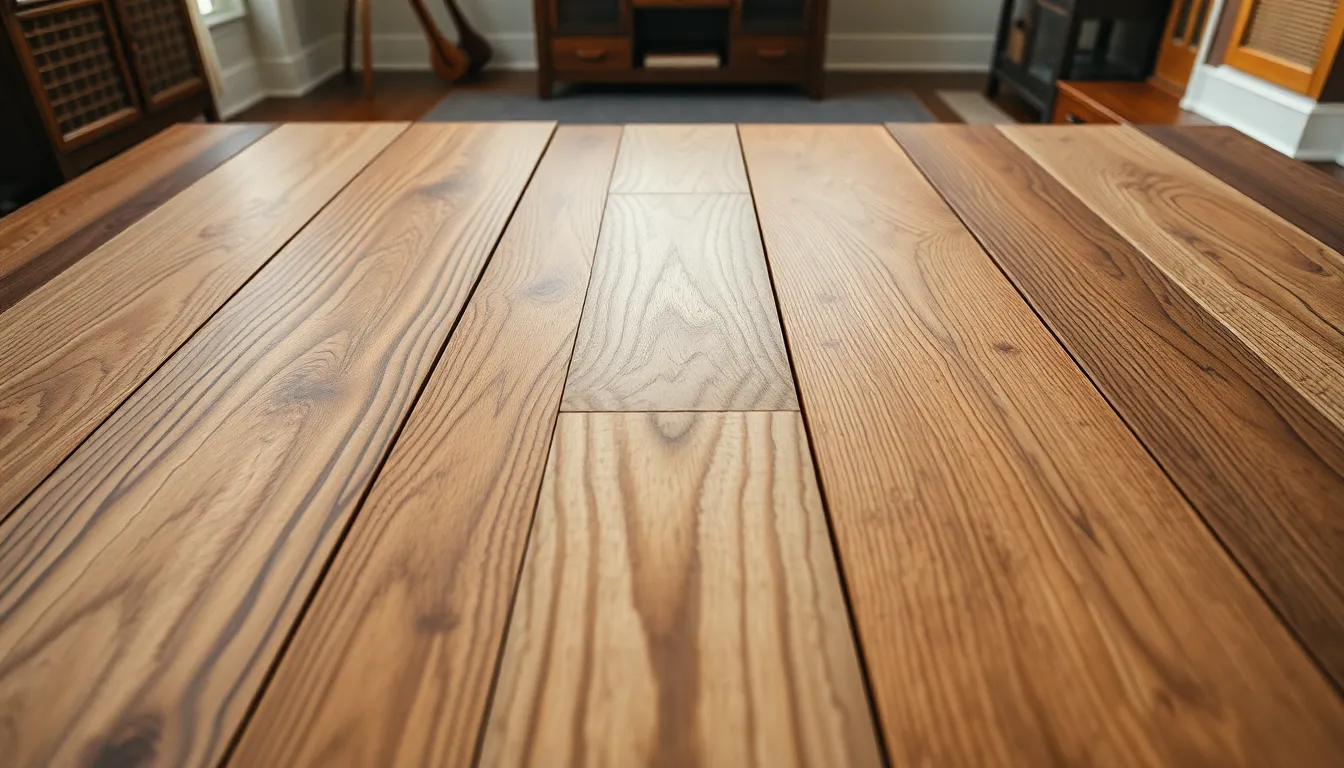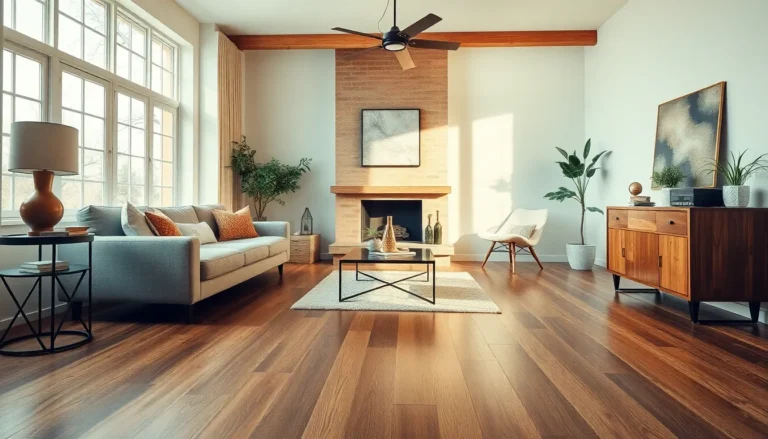Table of Contents
ToggleWhen it comes to flooring, hardwood isn’t just a choice; it’s a lifestyle. Imagine stepping onto a floor that feels as warm and inviting as a hug from your favorite aunt. Hardwood flooring brings that cozy vibe to any home, transforming spaces into stunning showcases of natural beauty. Plus, it’s durable enough to withstand the antics of kids, pets, and the occasional dance party.
But let’s be honest—who wouldn’t want to impress their guests with a floor that screams sophistication? With a variety of styles and finishes, hardwood flooring can match any decor, from rustic charm to modern chic. So, whether you’re looking to elevate your home’s aesthetic or simply want a surface that can handle life’s little messes, hardwood might just be the hero your floors deserve.
Overview of Hardwood Flooring
Hardwood flooring presents a choice that blends functionality and aesthetic appeal. Its natural beauty enhances interior spaces, creating an inviting atmosphere. Available types of hardwood include oak, maple, and hickory, each showcasing unique grain patterns. Durability ranks high among its benefits, making it suitable for high-traffic areas in homes.
Maintenance requirements are relatively straightforward, often needing only regular sweeping and occasional refinishing. Many appreciate its long lifespan, which can exceed 30 years with proper care. Style versatility allows hardwood to fit seamlessly with traditional and contemporary designs. Options for finishes, such as matte or glossy, accommodate various design preferences.
Installation methods vary, including nail-down, glue-down, and floating floors. Professional installation ensures proper fitting and longevity. Cost considerations may include not only the price of materials but also labor charges. Seasonal changes can affect hardwood, causing slight expansions and contractions; acclimating the wood before installation mitigates potential issues.
Environmental sustainability also makes hardwood flooring appealing. Choosing lumber from responsibly managed forests supports eco-friendly practices. A variety of resources, including local suppliers, facilitate finding hardwood options that match budgets and aesthetics.
Overall, hardwood flooring stands out as a practical and stylish flooring solution, offering numerous advantages that cater to diverse homeowner needs.
Types of Hardwood Flooring

Hardwood flooring comes in two primary types: solid and engineered. Each type provides unique benefits suited for different applications and preferences.
Solid Hardwood Flooring
Solid hardwood flooring features planks made from single pieces of wood. This type offers durability and can be resanded multiple times, extending its lifespan. Common wood species include oak, maple, and cherry, each showcasing distinctive grain patterns. Solid hardwood tends to expand and contract with humidity changes, making it best for stable environments. For installation, tongue-and-groove methods are frequently used. Maintenance involves regular sweeping and occasional refinishing to enhance its natural beauty.
Engineered Hardwood Flooring
Engineered hardwood flooring consists of multiple layers, with a veneer of solid wood on top and plywood or high-density fiberboard beneath. This construction provides greater resistance to moisture, making it suitable for basements and areas with fluctuating humidity. Various wood species can be selected for the top layer, offering many design options. Engineered flooring can be installed over concrete, reducing installation challenges. Maintenance is straightforward, often requiring just cleaning with a damp mop, preserving its elegance and functionality.
Benefits of Hardwood Flooring
Hardwood flooring offers numerous advantages that enhance both the functionality and aesthetics of a home. From its visual appeal to its practicality, hardwood stands out among other flooring options.
Aesthetic Appeal
Hardwood flooring adds character and elegance to any space. Various wood species, including oak, maple, and hickory, feature distinct grain patterns that provide a unique look. Options in finishes allow for customization, ensuring homeowners find a match for their decor style. Whether it’s a modern, rustic, or traditional aesthetic, hardwood complements multiple design choices, elevating the overall ambiance of a room.
Durability and Longevity
Durability characterizes hardwood flooring, making it an ideal choice for busy households. Solid hardwood can withstand heavy foot traffic, while engineered hardwood offers moisture resistance. With careful maintenance, hardwood floors can last over 30 years. Resurfacing reveals fresh layers of wood, extending their lifespan. This longevity not only provides value but also reduces the frequency of replacements, making hardwood a cost-effective choice.
Easy Maintenance
Maintaining hardwood flooring proves to be straightforward, requiring minimal effort. Regular sweeping removes dirt and debris, while occasional damp mopping restores shine. The need for extensive cleaning is rare, making it suitable for families with children and pets. Depending on the finish, refinishing every 5 to 10 years helps preserve appearance. With its resilient surface, hardwood resists staining, adding to the ease of upkeep.
Installation Process
Installing hardwood flooring requires careful planning and specific tools. Preparation ensures a smooth process, leading to a professional finish.
Preparation and Tools Needed
Essential tools include a saw, measuring tape, chalk line, and nail gun. A moisture meter gauges humidity levels, ensuring the subfloor is suitable. Owners should also have floor spacers to maintain expansion gaps and a mallet for adjustments. Conducting initial measurements prevents costly mistakes. Cleaning the installation area removes debris and dust for a better bond.
Step-by-Step Installation Guide
Start by acclimating the hardwood planks for 72 hours in the installation area. Measure and cut the first row, leaving an expansion gap near the wall. Lay down the underlayment before placing the first plank to reduce noise and moisture. Use the nail gun to secure each plank in place, working from left to right. Ensure seams stagger for stability. Continue this process until the last plank, measuring and cutting as needed. Finally, install transition strips to complete the look.
Cost Considerations
Understanding the costs associated with hardwood flooring is crucial for homeowners seeking to enhance their living spaces. This section outlines key pricing aspects and additional expenses that may arise during the installation process.
Price per Square Foot
Average prices for hardwood flooring range from $3 to $12 per square foot. Oak typically sits at the lower end of this spectrum, while exotic woods like teak may reach the upper limits. Factors like quality, species, and finish significantly influence these prices. Installation costs should also be factored in, as they can add an additional $2 to $5 per square foot depending on the complexity of the project and the contractor’s rates. Choosing a higher quality material or finish often results in increased longevity and aesthetic appeal.
Additional Costs to Consider
Beyond the price per square foot, several additional expenses arise when installing hardwood flooring. Homeowners should anticipate costs for underlayment, which generally ranges from $0.50 to $1.50 per square foot and affects comfort and sound insulation. If old flooring requires removal, disposal fees may apply, costing between $1 and $3 per square foot. Furthermore, maintenance expenses, such as refinishing, can add up over time. Refinishing typically ranges from $1.50 to $5 per square foot, a crucial factor in preserving the floor’s appearance and durability.
Hardwood flooring stands out as a timeless choice for homeowners seeking elegance and durability. Its ability to enhance any space while providing a warm and inviting atmosphere makes it a preferred option. With various styles and finishes available, it suits diverse tastes and complements any decor.
The straightforward maintenance and impressive lifespan further add to its appeal. Homeowners can enjoy the beauty of hardwood for decades with proper care. By understanding the types, costs, and installation methods, they can make informed decisions that elevate their homes. Ultimately, hardwood flooring isn’t just a surface; it’s an investment in lasting beauty and functionality.







